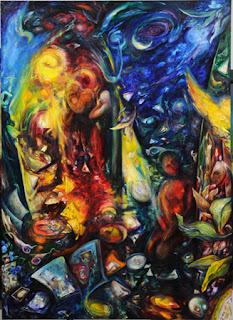“In Silent Touch My Purchase Seen”
84”x60” oil on canvas 2013
Disparate
Though
they be
Distant,
unimaginable, yet
Divine
in silent touch
Upon
each singular moment
In
this, the tenuous convention
Trust,
found, deep within to be.
November
20, 2013
This painting comes out of the idea of finding purchase
within this chaotic life, of finding a quiet balance, a quiet space within.
Again, from my journal:
There are many gates that open upon this hill, this mountain
that we all ascend towards understanding, towards enlightenment. Journeys that
take one far and wide, to search, to struggle to find purchase and gain hope.
It is this, to find that singular moment, that fragment, that glimpse that
becomes the key that unlocks the gate into the garden of impassioned
understanding free from convention and traditional thinking.
Angelic warriors, ancestors, those who have gone before,
line up to offer solace, a shimmering glance of hope; a piece of illuminating
light. This is the gift offered and one received. This is the purchase found
that gains us balance as we continue upon this ascended path.
It is in this act of transcending that common value, of
stepping outside of the humaneness, rejecting the chaos that surrounds and
consumes us, even for brief moments. In this we find a quiet strength and a
glimmer of the truth that we hold inside.
December 6, 2013
The next step is to frame this piece so I can see it as it
will be when finished. Then after long hours of contemplation finish the
glazing even as I begin the next canvas.
JDW























